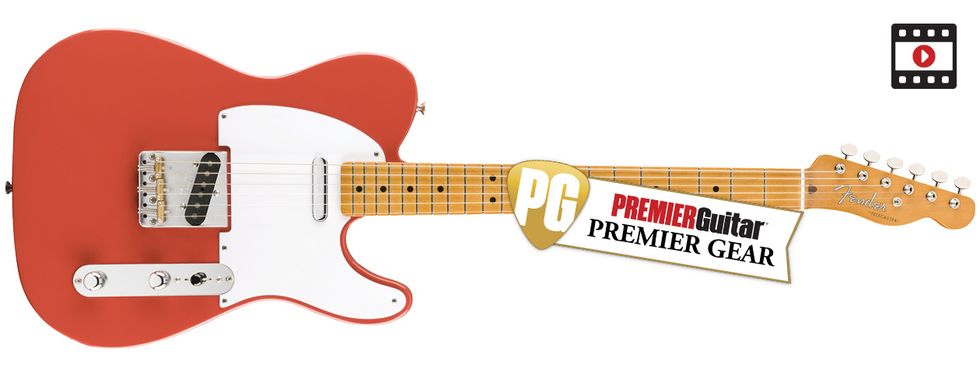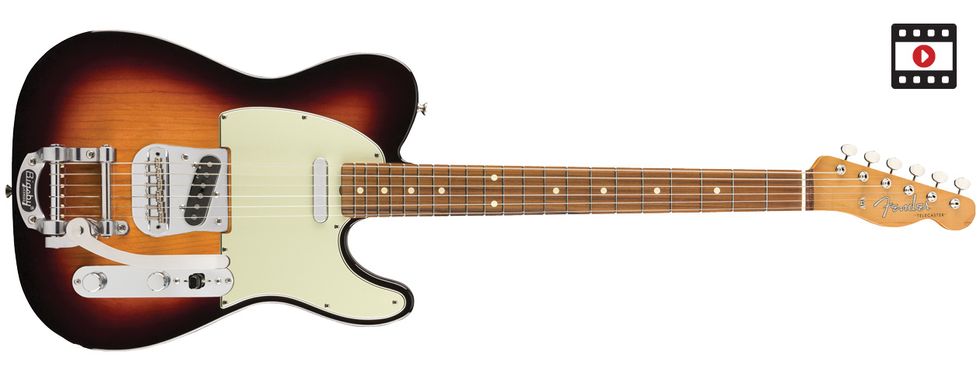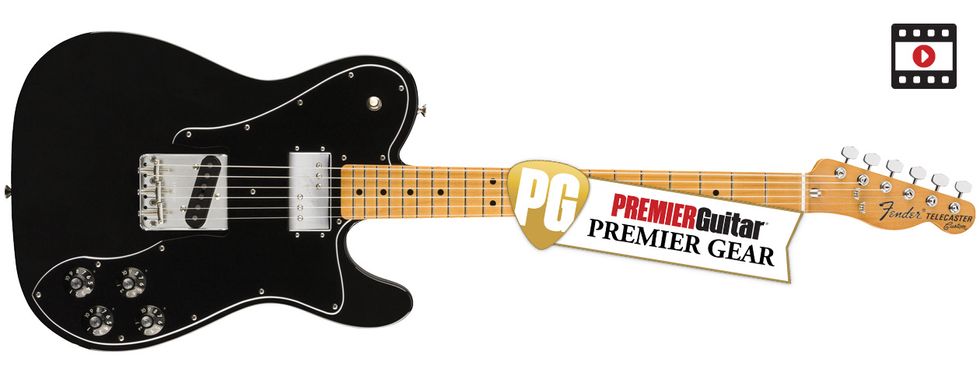Perfection is an elusive, mostly impossible ideal. But damn, the Fender Telecaster comes close. Beautiful, balanced, stable, malleable, versatile, and tough-as-nails—it succeeds fantastically as a tool of musical expression and as a landmark of industrial design.
But one of the most unsung, even paradoxical, aspects of Telecaster’s intrinsic design integrity is its capacity for evolution. Like a line of calligraphy, the simple, elegant Telecaster’s intent, attitude, and sound can be transformed with the addition of just a few elements.
Whether Leo Fender was the driver of change, or the much-maligned bosses of the CBS era, Fender consistently grasped the blank-slate essence of the Telecaster—enacting changes that would stoke creativity and prompt fiery debate. And by the time the mid ’70s rolled around, the Telecaster (which began life as the one-pickup Esquire and was briefly called the Broadcaster) would morph into the original bound Telecaster Deluxe, the Thinline, the two-humbucker Thinline and Deluxe, and the single-coil/humbucker hybrid Custom.
Fender’s ambitious, sprawling new Vintera series, which includes the three Telecasters reviewed here, traces the evolutions spanning the Telecaster’s birth in 1950 and the early ’70s. And a casual scan of the new Vintera offerings underscores that there’s more to this series than a few new vintage paint colors. The standard Vintera guitars mark a return to vintage specs like a 7.25" fretboard radius and period-correct pickup magnets. But the series also includes the Vintera Modified guitars, which mate vintage styling to modern Fender modifications like S1 phase switching and a 9.5" fretboard radius. All told, there are seven Telecasters in the Vintera line.
We would have loved to play every Vintera instrument, decode their specs and secrets, and discuss their merits for the benefit of you, the reader. In the end, we kept this review to just three models—the Vintera ’50s and ’60s Telecasters and the ’70s Telecaster Custom. These guitars piqued our interest—first because they mark a return to many vintage specifications at a very accessible price, but also because the Telecaster was the vehicle for some of the most interesting changes of the vintage era.
While choosing the right Vintera guitar will be labyrinthine for some, at day’s end the series’ expansiveness means a load of tone options and a super-fun way to explore your own neck shape and pickup preferences. We trust this Telecaster-centric scratching of the Vintera surface will lend a little insight into the design differences behind Fender’s new trove of affordable classics.
Click 'Next' or Select Your Tele below:
Vintera ’50s Telecaster
Vintera ’60s Telecaster Bigsby
Vintera ’70s Telecaster Custom
Watch the First Look:

RatingsPros:A visceral, immediate vintage Telecaster experience. Fantastic neck. Beautiful chiming bridge pickup tones. Cons: Polyester finish seems a bit thick. Finish on neck can feel relatively sticky. Street: $899 Fender Vintera ’50s Telecaster fender.com | Tones: Playability: Build/Design: Value: |
Vintera ’50s Telecaster
In strictly visual terms, you could argue Fender never improved on the first Telecaster. With 1-ply pickguards and maple necks, they are exquisitely simple and highlight the instrument’s super-elegant, minimalist lines. I’ve always had a preference for Fender’s ’60s rosewood necks, especially on the Telecaster. But it’s amazing what a few weeks of having a maple-neck Vintera ’50s sitting around the house, basking in afternoon sunlight, can do to alter such biases. The shiny, lacquered neck looks just right and the warm maple hues highlight the perfect curves and proportions of the Telecaster headstock and body. Call me a convert.The Vintera ’50s neck isn’t just visually appealing, though. It’s built around an early-’50s U profile that may feel startlingly fat by modern standards, but it is ergonomically satisfying, to say the least. I noticed a lot less hand fatigue after an hour than I experience playing slimmer Fender necks. It also fills the hand in a way that compels you to dig deep into bends and creatively wrestle with the guitar. It isn’t what most folks would call a “fast” neck. But if there was any impediment to fretting hand mobility, it had more to do with the gloss finish than the girth.
If you’re not hung up on the neck’s thickness, you’ll likely end up inspired by the playing approaches it seems to invite. On one hand, the inherent stability of the fatter neck provokes physical, roughneck interaction with the instrument. On the other, there is something about its heft that makes languid, melodic picking and chording feel easy and inviting. If you think you know big Fender necks, or primarily associate ’50s-style Fenders with deep-V profiles (which can feel positively alien to the uninitiated), you’ll be well served by putting aside preconceptions and checking out this alternative.
On the output side of the equation, the Vintera ’50 is a thrill. If you were a producer and needed the raw, unadulterated sound of primitive rock guitar on a track, it would be hard to top the bright, biting, and concise sounds of a ’50s-style Telecaster bridge pickup plugged straight into a loud Fender combo amp. (It’s little wonder that maple-neck Telecasters appear so often in photos of the Wrecking Crew at work—Tommy Tedesco’s rosewood 1960 model aside.) But the 7.1k-ohm bridge pickup is much more than just bright. The alnico 2 magnets impart a warm glow around transients that can be effectively softened further through guitar tone and volume attenuation. The 5.4k-ohm neck pickup is much more mellow, and it’s easy to understand why hard-rock players often replaced this pickup with PAF humbuckers and Firebird pickups in the ’60s. But I loved its soft, pillowy voice for soul rhythms and subdued melodic counterpoint. The combined pickup voices, meanwhile, impart an almost acoustic-like airiness that enables you to play jangling and strummy accompaniment without being too bossy.
For players who find the Vintera ’50's' graceful, understated simplicity too simple, the ’50s Vintera Modified Telecaster with slightly hotter pickups, a lovely soft-V satin finish neck, and super-versatile series/parallel and S1 phase switching is an excellent alternative and a superb guitar by any measure. But it’s hard to beat the visceral, electric sensation of direct, main-line connection that you get from the ’50s Vintera Telecaster. I love this guitar.
Click 'Next' or Select Your Tele below:
Vintera ’60s Telecaster Bigsby
Vintera ’70s Telecaster Custom
Watch the First Look:

RatingsPros:Twangy as heck—even without the Bigsby. Jangly, even, and airy mid-forward voice. Superb neck-pickup tones. Cons: No Bigsby-less option for getting ’60s-spec model. Jazzmaster-style saddles rob some Tele spank. Pale coloration on pao ferro fretboard. Street: $999 Fender Vintera ’60s Telecaster Bigsby fender.com | Tones: Playability: Build/Design: Value: |
Vintera ’60s Telecaster Bigsby
There have been phases in my life when I considered a Bigsby-equipped ’60s Telecaster the ideal electric guitar. Even though the clunky, contraption-y Bigsby can be an odd match for Zen perfection of the Telecaster’s lines (on some days it looks to me like someone glued motorcycle parts to the top), the expressive utility of having one of the greatest-ever vibrato systems mated to one of the greatest-ever electric solidbodies more than offsets challenges to my aesthetic sense. In fact, the Bigsby makes the Vintera ’60s Telecaster that much more addictive. And you start to hear music in your head just by looking at it—primarily Alessandro Alessandroni and Steve Cropper riff duels punctuated by surfy vibrato dives and wooly soul-chord melodies.The sunburst finish and mint pickguard are a lovely pairing—looking dessert delicious, like a dish of crème brûlée with cream on top—and the honey hues of the aged maple neck and headstock are a perfect complement. On our review guitar at least, you can see why some players have lamented the move to pao ferro from rosewood for Vintera-series fretboards: Our specimen had a particularly pale complexion. That said, the pao ferro fretboard on the Vintera ’60s Modified we had on hand for comparison was much darker, and it’s hard to imagine that a few years of gigging and hand oil won’t find this fretboard turning a darker, more seasoned shade. The neck itself feels authentically ’60s, with just a bit more mass and bump in the curve than modern-C necks. It’s an excellent alternative for anyone that finds the slimmer, flatter combination of a modern-C and 9.5" too slim and flat, or the ’50s U-profile too fat. (And should you start to obsess about a more curvaceous radius choking your bends, just remember that Jimi Hendrix, Jimmy Page, David Gilmour, and thousands of other players managed to get pretty freaking bendy on 7.25"-radius fretboards.)
The neck pickup will please anyone put off by the mellow output of the Vintera ’50s pickup. The 7.5k-ohm, alnico 5 unit is actually wound hotter than the 6.9k-ohm bridge unit and feels punchy, immediate, and responsive to pick dynamics. But it’s also softened by a very balanced low-mid presence that yields Stratocaster neck-pickup overtones (this guitar rules for Hendrix/Mayfield-style balladry) and sounds dreamy through a Fender combo amp dripping with spring reverb. Add a little Bigsby wobble to the recipe and the results are positively heart swelling.
The alnico 5 bridge pickup is less mid-scooped than a ’50s bridge pickup. It’s jangly and, not coincidentally, a lovely match for a scooped and ’verb-y mid-’60s blackface combo. But the output of both pickups is almost certainly colored by the Bigsby and the Jazzmaster-style saddles and bridge. The improved intonation you can achieve with these saddles is a real plus. But the bridge is much less conducive to the sustain you associate with a Telecaster and seems to rob the pickups of some low-end mass. How this tone recipe fits in your style is a matter of preference. As a regular player of Jazzmasters, Jaguars, and Rickenbackers, this general tone profile suits my worldview perfectly. More heavy rock-centric players may dig it less. One thing is for certain, the Vintera ’60s Telecaster twangs like a mother. If you’re after Don Rich’s low-E string “thwack,” it’s here by the bucketful.
Click 'Next' or Select Your Tele below:
Vintera ’50s Telecaster
Vintera ’70s Telecaster Custom
Watch the First Look:

RatingsPros:Growly bridge pickup. Airy, dimensional humbucker tones. Cool combination of light, fast feel and heavy sounds. Cons: Humbucker could be a touch more jangly. Neck feels thinner than some vintage examples. Street: $899 Fender Vintera ’70s Telecaster Custom fender.com | Tones: Playability: Build/Design: Value: |
Vintera ’70s Telecaster Custom
It’s hard to know who was first to swap out a ’50s Telecaster neck pickup for something punchier. Terry Reid and Steve Marriott were early adopters of the practice. Keith Richards made it a very high-profile modification not long thereafter. And while Fender’s CBS-era leadership is legendarily regarded as out of touch, someone at Fender clearly took notice of the trend. Just one short year after Keith famously stuffed his ’54 Telecaster with a humbucker in the neck position, Fender introduced the Custom, featuring a Telecaster single-coil and the Seth Lover-designed Wide Range humbucker. Given that Keith himself would adopt the model for his own a few short years later, it’s probably safe to deem the experiment a success.
Despite Keef’s unofficial endorsement, the ’70s Custom took a beating from vintage purists for much of its history. At a time when many players viewed the electric guitar world through the lens of a Manichean Gibson/Fender divide, the Custom and its two-humbucker brothers, the Thinline and Deluxe, seemed to be too much—or not enough—of either. Aesthetically speaking, the Custom—like the Thinline and Deluxe—is a mixed bag. It lacks the design economy and grace of the ’50s-era Telecasters, and the oversized pickguard and Wide Range pickup cover tend to be love-or-hate propositions. But I dig the way it echoes design evolutions in muscle cars from the period—suggesting swagger and potency without totally obscuring the basic design’s more modest, utilitarian origins. In its all-black guise in particular, it has a cool aura of menace, like a stripped-down Chevelle idling at a light, ready to pounce.
While the 4-knob control array and humbucker acknowledge major Gibson influence, the Custom still feels quintessentially Fender in hand, and the combination of the two can take you down many unexpected avenues. The ability to set up the two pickups for wildly different tone profiles opens up scads of expressive and compositional possibilities. And while the Wide Range humbucker isn’t as wooly as a Gibson PAF, the possible contrasts between the barking Tele bridge pickup and a tone-attenuated Wide Range are often more intriguing and expansive than the duel-humbucker palette.
Contrasts aside, this alnico 5 version of the Wide Range humbucker is a great match for the Telecaster bridge pickup. Fender’s Tim Shaw tinkered significantly with a wider, more vintage-correct bobbin spacing. The result is much more low-end color and punch, a softer top end, and considerably more depth of field and air than you hear from Wide Range units in older Mexico-made Fenders. The bridge pickup is very similar to the Vintera ’60s Telecaster and shares that unit’s alnico 5 magnets, staggered pole pieces, and 6.9k-ohm resistance. But Shaw’s team wound the pickup for more pronounced midrange, which helps make the Custom punchier and growlier than its ’60s counterpart in the bridge position.
The original Telecaster Custom may have underachieved as a Gibson alternative for not being Gibson enough. But this Vintera version underscores what a singularly cool guitar it is for its own many idiosyncrasies. The available tone combinations are numerous and capable of communicating many moods—including some quite outside the realm of traditional Telecaster-ness. But it’s the combination of streamlined, lightweight feel and a brash-to-brawny voice that make the Custom so unique and such a gas to play.
Click 'Next' or Select Your Tele below:
Vintera ’50s Telecaster
Vintera ’60s Telecaster Bigsby
Watch the First Look:









![Rig Rundown: Russian Circles’ Mike Sullivan [2025]](https://www.premierguitar.com/media-library/youtube.jpg?id=62303631&width=1245&height=700&quality=70&coordinates=0%2C0%2C0%2C0)


























